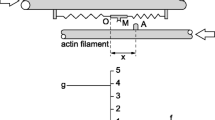Abstract
The optimal systems approach to the muscular system leads to difficulties since the properties of the muscular system are determined to a great extent by the nature of the contractile unit or molecule. This unit has determined the morphology and dynamic characteristics of muscle, and only smaller order alterations are then possible to adapt muscle to its several functions.
A model of the contractile unit is developed that shows agreement with experimental findings with respect to the velocity-load relation, heat effects, and several aspects of knowledge of the structure of the contractile proteins.
Similar content being viewed by others
Literature
Buchtal, F. and E. Kaiser. 1951. “The rheology of the Cross Striated Muscle Fibre.”Dan. Biol. Medd.,21, 1–318.
Cohn, D. L. 1954. “Optimal Systems: I. The Vascular System.”Bull. Math. Biophysics,16, 59–74.
— 1955. “Optimal Systems: II. The Vascular System (Cont'd.)” —Ibid.,,17, 219–27.
Davson, H. 1952.A Textbook of General Physiology. Philadelphia: The Blakiston Company.
Dubuisson, M. 1954.Muscular Contraction. Springfields, Ill.: Charles C. Thomas.
Hill, A. V. 1938–39. “The Heat of Shortening and the Dynamic Constants of Muscle.”Proc. Roy. Soc., B,126, 136–95.
— 1949. “Does Heart Production Precede Mechanical Response in Muscular Contraction?” —Ibid.,,137, 268–73.
Mommaerts, W. F. H. M. 1950.Muscular Contraction. New York and London: Interscience Publishers.
Needham, D. M. 1950. “Myosin and Adenosinetriphosphate in Relation to Muscular Contraction.”Biochimica et Biophysica Acta,4, 42–49.
Pauling, L. and R. B. Corey. 1951a. “The Pleated Sheet, a New Layer Configuration of Polypeptide Chains.”Proc. Nat. Acad. Sci.,37, 251–60.
— 1951b. “The Structure of Hair, Muscle, and Related Proteins.” —Ibid.,,37, 261–71.
Pauling L., R. E. Corey, and H. R. Bramson. 1951. “The Structure of Proteins: Two Hydrogen-Bonded helica Configurations of the Polypeptide Chain.”Proc. Nat. Acad. Sci.,37, 205–11.
Polissar, M. J. 1952. “Physical Chemistry of Contractile Process in Muscle.”Am. Jour. Physiol.,168, 766–811.
— 1944. “Muscle: Physics.”Medical Physics, I, pp. 784–98. (Ed. O. Glasser). Chicago: The Year Book Publishers.
Ramsey, R. W. 1947. “Dynamics of Single Muscle Fibers.”Ann. N.Y. Acad. Sci.,47, 675–95.
Rashevsky, N. 1948.Mathematical Biophysics. Chicago: The University of Chicago Press.
Szent-Gyorgyi, A. 1951.Chemistry of Muscular Contraction. New York: Academic Press.
Wilkie, D. R. 1954. “Facts and Theories about Muscle.”Progress in Biophysics, IV, pp. 288–324. (Ed. J. A. V. Butler and J. T. Randall) New York: Academic Press.
Author information
Authors and Affiliations
Rights and permissions
About this article
Cite this article
Cohn, D.L. Optimal systems: III. Muscle. Bulletin of Mathematical Biophysics 17, 309–329 (1955). https://doi.org/10.1007/BF02477756
Received:
Issue Date:
DOI: https://doi.org/10.1007/BF02477756




